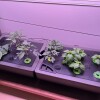Did you hear about the couple who met at the garden center while shopping for houseplants? It was a budding romance.
During the pandemic, garden centers saw a 50% increase in houseplant sales, and the popularity of indoor plants has continued strongly, with Millennials and Gen Z generations joining the ranks of older houseplant enthusiasts.
ADVERTISEMENT
Our fascination with houseplants began during the Victorian era, when central heating in homes made it possible to create an environment in which indoor plants, many of which are tropical in nature, could survive and thrive.
Houseplant enthusiasm ebbs and flows, and we’re currently at a high point. Trending are large tropical houseplants, miniature indoor gardens, bonsai and fairy gardens. Terrariums are even popular again, rediscovered from the 1970s.
How long can a houseplant be expected to live? The oldest potted houseplant in the world is having its 250th birthday this year and can be seen at England’s Kew Gardens Conservatory. The amazing Eastern Cape cycad first arrived at Kew in 1775 after botanist Francis Masson brought it back from its native South Africa, and it’s been potted ever since.
That gives houseplant enthusiasts encouragement that our plants can be with us for many years. While most of us probably won’t keep our indoor plants alive for the next 250 years, is there a ballpark lifespan of a houseplant?
Most plants that humans adopted as indoor plants are native outdoors somewhere, usually tropical jungles or desert climates. In their natural habitats, they’re often tree or shrub-like, and capable of living many years.

There’s not an automatic kill switch that causes houseplants to die after a certain number of years. Theoretically, most perennial plants can live forever, or at least until something goes wrong.
Something usually does go wrong eventually, with plants succumbing to insects, disease, unsuitable light or improper care. Some plants are more susceptible to issues, which is why some enjoy long lives, while others are short-lived.
ADVERTISEMENT
The lifespan of a houseplant is almost completely in our own hands, because we control most of the factors in which we place our plants, unlike an outdoor plant that is at the mercy of nature’s elements like hail, wind, drought and swarms of locusts.
What are the common causes that shorten a houseplant’s life, and how can we avoid them?
Overwatering has long been called the number one killer of houseplants. We can be so concerned that a plant will die from neglect that we compensate by drowning it.
Overwatering doesn’t mean applying too much water at one time, since the overage should drain out the pot’s bottom and can be discarded. Instead, overwatering means too-frequent watering that keeps the soil continually soggy.
The old rule of thumb still applies for most houseplant types: When watering a plant, water it thoroughly, meaning we should apply enough to wet the entire soil ball within the pot until a little drains out the bottom, which should then be discarded.

Then allow the soil to dry between thorough waterings. The human finger is still a handy and effective moisture meter. Insert a finger into the soil up to the first joint, which is about 1 inch. If you feel moisture at the fingertip, the roots have enough water, so wait a day or two and check again. If you don’t feel moisture, water thoroughly.
Is there a rule of thumb for how often houseplants should be watered? There are too many factors such as heat, air circulation, humidity and pot size to set a hard-and-fast scheduled watering regimen. Instead, check them on a regular schedule, but only water if your finger determines they need it.
ADVERTISEMENT
Plants can also die from neglect. Watering only when we happen to think about it is the opposite of overwatering, and both extremes are harmful.
Improper light levels, often too little, also shorten the lifespan of indoor plants, as do insect populations allowed to explode.
Houseplants also languish if the soil runs out of nutrients. Fertilizing when daylength increases in spring and summer, plus repotting into fresh soil every few years, can keep a plant well nourished.
Plant types with a proven track record of longevity include Christmas cactus, jade plant, Boston fern, rubber plant, snake plant, weeping fig, spider plant and English Ivy. Many become heirloom plants, handed down from generation to generation.













